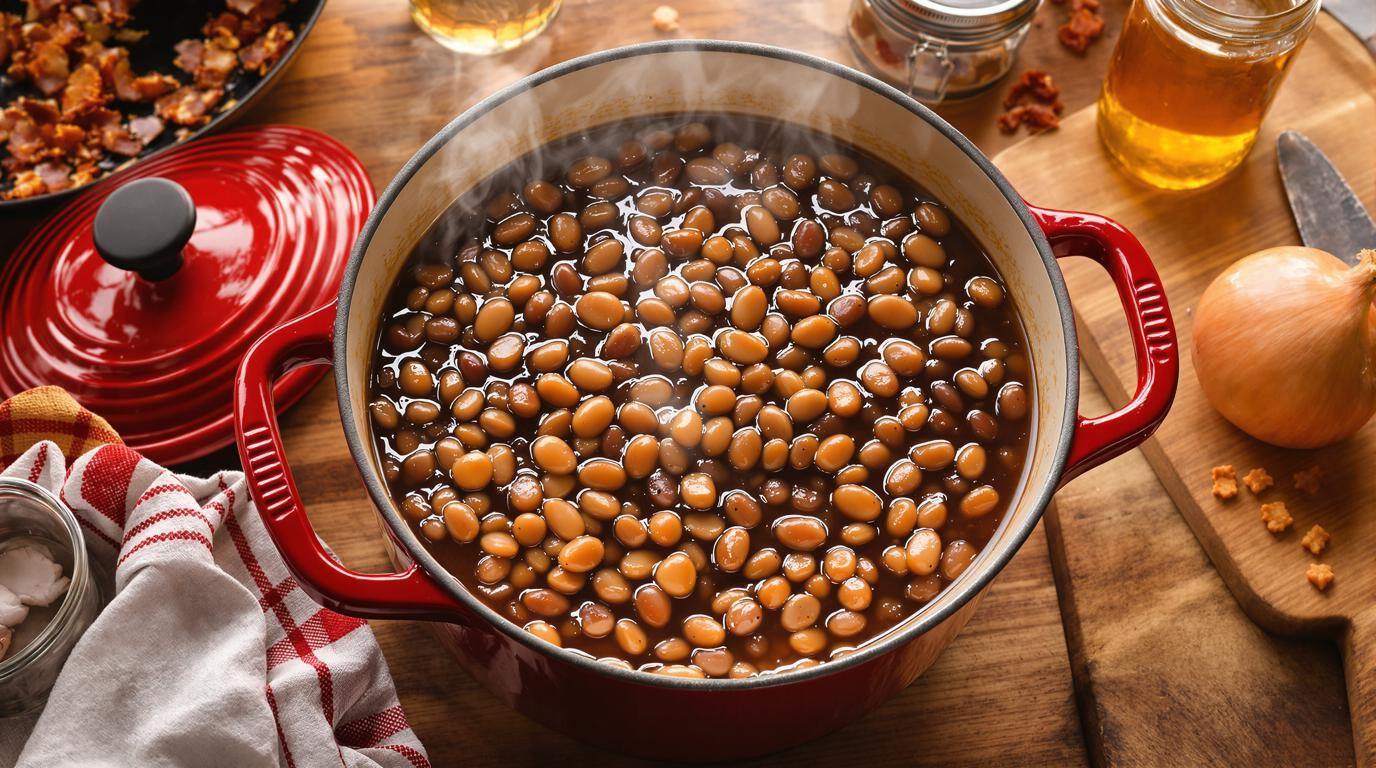There’s something almost magical about a pot of baked beans slowly transforming in the oven, filling the kitchen with sweet, smoky aromas that seem to whisper stories from generations past. Growing up, my grandmother’s baked beans were a fixture at every family gathering – their molasses-rich depth signaling that good times were ahead. What many don’t realize is that these humble beans have sustained New Englanders through harsh winters since colonial times, when Saturday bean suppers became tradition in homes across the northeast. Let me share with you my grandmother’s authentic recipe that delivers that perfect balance of sweet, savory, and deeply satisfying flavor that’s been perfected over centuries.
The Story Behind Grandmother’s Baked Beans 📖
Traditional baked beans aren’t just food – they’re cultural heritage in a bean pot. In early American settlements, beans would cook slowly in brick ovens on Saturday while families observed the Sabbath, resulting in a hearty Sunday meal requiring no cooking. My grandmother learned her recipe from her mother, who brought it from Quebec where molasses-sweetened beans were a staple in lumber camps and family kitchens alike. While modern shortcuts exist, there’s something profoundly satisfying about honoring the slow, intentional process that produces beans with soul-satisfying depth.
Essential Ingredients 🧾
The beauty of traditional baked beans lies in their humble ingredients:
- 2½ cups (500g) dried navy beans
- 1 cup (225g) diced bacon (or salt pork for authenticity)
- 1 medium onion, finely chopped
- 1 cup (240ml) molasses
- ¼ cup (50g) brown sugar
- 2 tablespoons ketchup
- 1 teaspoon yellow mustard
- ½ teaspoon salt
- ¼ teaspoon freshly ground black pepper
- Water as needed
Chef’s Note: Navy beans are traditional and hold their shape beautifully, but Great Northern beans make an acceptable substitute. For those seeking vegetarian options, replace the bacon with 2 tablespoons of olive oil and 1 teaspoon of smoked paprika to maintain that crucial smoky depth.
Step-by-Step Instructions 📝
This is slow food at its finest – patience rewards exponentially:
- Place beans in a large bowl and cover with cold water by at least 2 inches. Soak overnight or for at least 8 hours.
- Drain and rinse the soaked beans. Transfer to a large pot, cover with fresh water, and bring to a boil. Reduce heat and simmer for 30-45 minutes until beans are tender but still hold their shape. Drain, reserving 1 cup of cooking liquid.
- Preheat your oven to 300°F (150°C).
- In a skillet, cook the diced bacon until it begins to crisp. Remove bacon with a slotted spoon and set aside.
- In the bacon drippings, sauté the onion until translucent, about 5 minutes.
- In a deep casserole dish or bean pot, combine beans, bacon, sautéed onions, molasses, brown sugar, ketchup, mustard, salt, and pepper. Stir gently to combine.
- Add enough reserved bean liquid to just barely cover the beans.
- Bake uncovered for 3-4 hours, checking occasionally and adding more liquid if needed to prevent drying out. The surface should develop a beautiful dark caramelization.
Chef’s Secret Techniques 🤫
The difference between good and extraordinary baked beans lies in the details. Never rush the soaking process – it’s crucial for even cooking and digestibility. When adding liquid during baking, always add hot liquid to maintain consistent cooking temperature. For deeper flavor development, consider creating a quick microwave roux with a tablespoon of flour in the bacon fat before adding to the beans – this creates incredible richness, similar to what makes gumbo so satisfying.
The best baked beans develop a dark, sticky crust on top – resist the urge to stir during the final hour of cooking to allow this crust to form. When you serve, make sure to scrape this flavor-concentrated layer into your serving dish!
Serving & Presentation Tips 🍽️
Traditional baked beans shine in their rustic presentation. Serve directly from the cooking vessel at the table for maximum impact, garnished with a few crispy bacon bits on top. These beans pair magnificently with crusty bread or a slice of citrus pound cake for dessert. For complete New England authenticity, serve alongside brown bread and franks.
These beans improve with age, developing even deeper flavor profiles after a day in the refrigerator. If making ahead, reheat gently with a splash of water to loosen. They freeze beautifully for up to three months – perfect for meal prep or as a quick side for crispy air fryer chicken.
I’ve shared this recipe countless times in my cooking classes, and students are always amazed at the transformation of such humble ingredients. Like mastering homemade gnocchi, perfecting traditional baked beans connects you to generations of cooks who understood that true culinary magic happens slowly, with patience and care. From my grandmother’s kitchen to yours, may these beans bring warmth and tradition to your table. 💕
